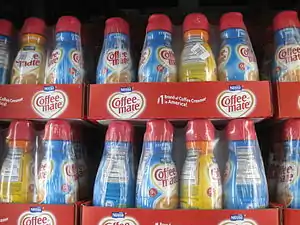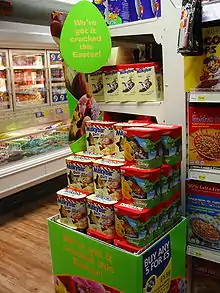Shelf-ready packaging
Shelf-ready packaging (SRP) and retail-ready packaging (RRP) (also prêt-à-vendre (PAV)) refers to the packaging of a product so that it is delivered to a retailer in packaging which is optimized for efficient stocking and sale.






Background
Retailers, particularly large big-box stores, superstores and warehouse clubs, sell large quantities of fast-moving consumer goods. These retailers often want to have items shipped from their distribution centers to the stores in unit loads and bulk boxes: these can be stocked without handling of the merchandise. The purpose of corrugated shipping containers is to put case goods directly onto shelves and stocking locations without individually handling the unit packs or primary packages. Retailers often require products to come in shelf-ready packaging to reduce stocking costs by saving labor expenses.
Ready-to-go display stands and end caps are put in the retail sales location by forklift trucks without assembly or manual handling of unit packs.[1] [2] [3]
Requirements
Retailers commonly specify all aspects of incoming logistics and packaging to their suppliers. This includes pallet size, bar code format and placement, RFID tags, strength of corrugated shipping containers etc. Boxes must be easy to open and prepare for stocking. Several designs are available.[4][5][6][7][8][9][10] Box perforations, tear tape, etc must be intuitive and easy. box cutters are often discouraged. Frequently, requirements for reusable packaging and sustainable packaging are also provided.
The principles of shelf-ready packaging are almost universal. Not all retailers, however, have the same detailed requirements. For example, Costcos "Structural Packaging Specifications",[11] Target's "Shelf Ready and Transit Packaging Standards, Hardgoods",[12] and Walmart's "RRP and PDQ Display Standard Style Guide"[13] are similar but not identical.
Regional coordination in Europe has produced an agreement on common functional requirements for the design of SRP. The Efficient Consumer Response (ECR), Europe Working Group, has published "Shelf Ready Packaging" to help standardize programs.[14]
Manufacturers and packagers need to keep the diverse requirements of the retailers in mind as they package and ship their products. Sometimes consultants and contract packagers with experience in shelf-ready-packaging are useful.
Types
Due to the fact that there are many different products which need to be packed in a SRP, products can be delivered by a variety of solutions.
Shelf tray
SRP solutions which can be placed in the shelf are predominantly made of corrugated cardboard. In general, these consist of a tray (secondary packaging) and a cover (a lid which protects the product). The cover can be easily separated from the tray by a perforation.[15] Sometimes the cover of a tray is a transparent film which protects the products from mechanical and climatic influences.[16]
Re-usable plastic tray
In addition to SRP made of corrugated cardboard, packaging can also be made of re-usable materials such as plastic. Such plastic containers can be re-used directly in the store. Furthermore, if re-use is not possible, the containers can be returned to the producer.[17]
Merchandising unit
Merchandising units represent another type of SRP solutions. They are used for secondary placement. Normally, promotional goods or fast-moving products are presented in a merchandising unit. An enormous number of products can be placed in a merchandising unit. Therefore, the merchandising unit serves as SRP.[18] Secondary placements can trigger impulse purchases. Often, roll-up palettes, called dollies, are used as a base for merchandising units. Rolling pallets facilitate the handling of merchandising units and increase flexibility.[19]
Importance of shelf-ready packaging
Shelf-ready packaging continues to be growing in many market segments, including over-the-counter pharmaceuticals. SRP helps retail stores to achieve cost savings in labor and in packaging materials. It also makes packaged products easier to spot for customers, resulting in better sales. Significant efforts and investments are usually made in improving aisle efficiency for consumers, ensuring consistent demand for suitable retail-ready products from physical outlets.[20]
See also
References
- US5850922A, Fraser, "Shipping and retail display pallet pack", published 1998
- US4919270A, Govang, "Pallet assembly for promotional display use and method of making same", published 1990
- US7131543B2, Mason, "Display device", published 2006
- US5881884A, Podosek, "Shipping and display carton and blank therefor", published 1999
- US6073833A, Desrosiers, "Shelf ready shipping container", published 2000
- US8342335B2, Couture, "Shelf-ready shipper display system", published 2013
- US20050184139A1, Couture, "Display-ready case", published 2005
- US6523692B2, Gregory, "Fold-in-half shipping/display box", published 2003
- US5372299A, Edgerton, "Combined product shipping and display box", published 1994
- US5657872A, Lefwich, "Shipping/display container", published 1997
- Structural Packaging Specifications (PDF), Costco, 2010, retrieved 24 August 2018
- Shelf Ready and Transit Packaging Standards, Target Australia, 2017, retrieved 24 August 2018
- RRP and PDQ Display Standard Style Guide (PDF), Walmart, 2016
- Shelf Ready Packaging (PDF), ECR Europe, 2016
- ECR Europe, GS1 Germany GmbH (2007), Handelsgerechte Regalverpackungen
- GS1 Germany (2008), Supply Chain Management
- ECR Europe, GS1 Germany GmbH (2007), Handelsgerechte Regalverpackungen
- ECR Europe, GS1 Germany GmbH (2007), Handelsgerechte Regalverpackungen
- o.V. (2008), Von Regaltray bis zu Logistikdisplays, In. Markenartikel
- Lingle, R (February 25, 2020), "How Retail-Ready Packaging Disrupts Food, Beverage and Pharma Markets", Packaging Digest, retrieved 14 April 2020